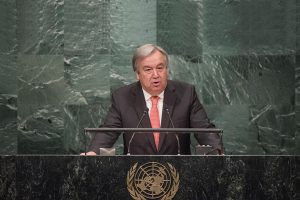By Marianne Beisheim and Silke Weinlich
In 2024, the UN will convene the Summit of the Future on the theme, ‘Multilateral Solutions for a Better Tomorrow.’ The Summit’s aim is to reinforce the UN and global governance structures to better address old and new challenges and to formulate a Pact for the Future that would help advance the SDGs by 2030.
Already before the SDG Summit in September this year (the so-called mid-term review of the Goals’ implementation), it is clear that, unless the pressure and pace are drastically increased, many Goals will not be achieved. Therefore, UN Secretary-General António Guterres conceives of the Pact for the Future as “a booster shot for the SDGs.” At the SDG Summit, Member States could define the areas where they want to make progress (the what), while strengthening multilateral capacities to do so at the Summit of the Future (the how), while also addressing gaps and new risks.
Diverse negotiation tracks
In August 2022, the Secretary-General indicated which of the negotiating tracks he regards as especially important for the Summit of the Future, and said he intends to publish policy briefs on the respective themes in the first half of 2023.
A result has already been achieved on meaningful youth engagement with the decision to establish a UN Youth Office. Intergovernmental negotiations are underway on the planned declaration on future generations, informed by an elements paper.
The track on a Global Digital Compact could gain momentum, co-facilitated by Rwanda and Sweden, with the support of the Secretary-General’s new Envoy on Technology. A code of conduct for greater integrity of public information, and progress on global rules for the peaceful, safe, and sustainable use of outer space are also envisaged.
An expert debate in August on the Secretary-General’s New Agenda for Peace concentrates on responding more effectively to old and new security risks and improving prevention, also by including regional partners. Work on a new standard for measuring prosperity (beyond GDP) is underway.
The Secretary-General is in discussions with international financial institutions (‘reform IFIs’) and planning a first biennial summit with the Group of 20 (G20), the UN Economic and Social Council (ECOSOC), and IFIs.
Through the UN’s role in the Black Sea Grain Initiative, Guterres fleshed out his concept of an Emergency Platform – agile, effective, and networked action that includes relevant stakeholders. In order to develop further proposals in this direction, the High-level Advisory Board on Effective Multilateralism will publish its recommendations in spring 2023.
The different tracks will be brought together in September 2023 at a preparatory ministerial meeting for the Summit of the Future, held back-to-back with the SDG Summit. Both the Secretary-General and many Member States want the two meetings to be closely coordinated and synergetic.
How to better tie the Summit of the Future to the SDGs?
So far there is not yet a very well-developed understanding of how the changes that are being discussed in the various tracks will “turbocharge” SDG implementation. A convincing narrative, complete with theories of change, is needed to maximize support for both agendas. This could include spelling out how the Summit of the Future can, inter alia:
- foster enablers of SDG acceleration such as digitalization and access to finance;
- tackle obstacles to SDG implementation, for example, through the New Agenda for Peace, by promoting effective crisis response through the Emergency Platform, by addressing fake news, and by supporting global public goods financing;
- reinforce international standards conducive for the SDGs, including Beyond GDP, ‘longtermism’ and rights for future generations, and of course those on human rights and gender; and
- develop a more networked, inclusive, and effective UN for SDG acceleration through the Emergency Platform, Youth Office, and a biennial summit with IFIs and the G20, among others.
The two agendas are also tied in other ways. Credible support for the 2030 Agenda and the SDGs, including concrete improvements in the area of UN development cooperation and financing, will be important – not least for rebuilding trust in international cooperation, which has taken a battering in many developing countries. Only then will it be possible to leverage consensus on the SDGs to also achieve progress towards a more effective multilateral system.
An opportunity to create a more capable UN for SDG acceleration
Secretary-General Guterres will brief Member States on his preparations for the Summit of the Future on 13 February, including the upcoming series of policy briefs. On 14 February, the co-facilitators for the Summit – the German and Namibian permanent representatives, Antje Leendertse and Neville Gertze, – will present their proposal for a roadmap for 2023. Further consultations with Member States and with major groups and other stakeholders are planned soon afterwards. They will provide an indication of the scope of further negotiations and the level of ambition to aim for in both September 2023 and in 2024.
The Summit of the Future offers a rare opportunity to bridge the considerable gap between the magnitude of the challenges the world is, and will be, facing and the agility and capacities of the UN to mount effective responses, partnering also with others to this end. Despite political differences, Member States should recall that a capable UN is in their best self-interest and seize the opportunity.
Dr. Marianne Beisheim is Senior Associate in the Global Issues Division of Stiftung Wissenschaft und Politik (SWP), the German Institute for International and Security Affairs. Dr. Silke Weinlich is Senior Researcher in the Inter- and Transnational Cooperation research programme at the German Institute of Development and Sustainability (IDOS).
This article is based on a longer paper published here.


